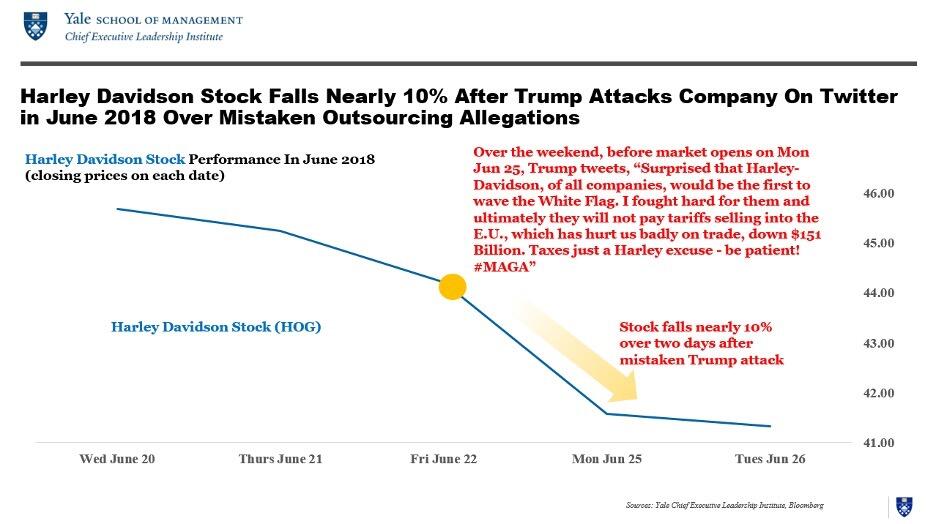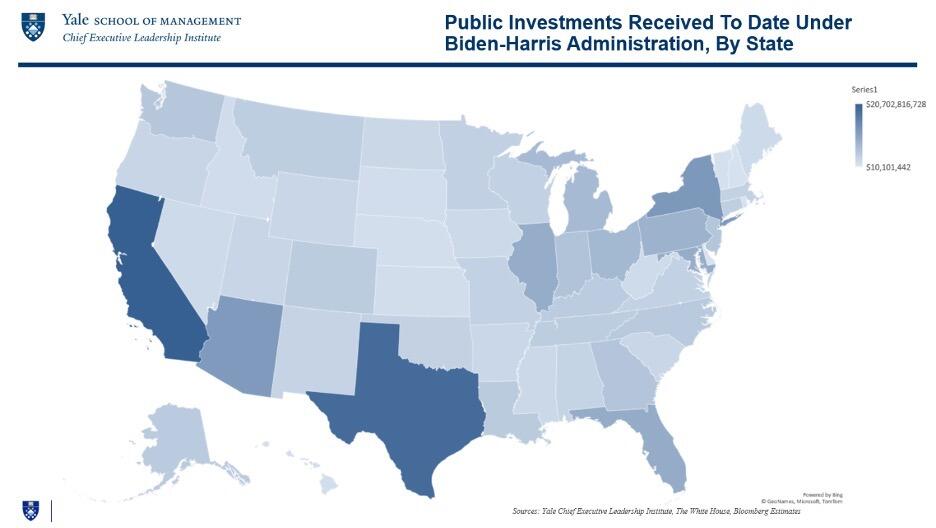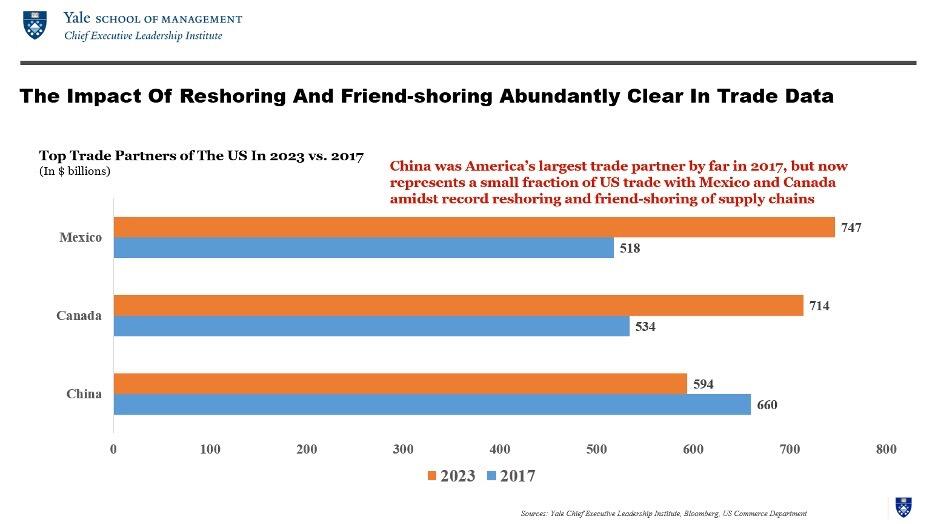Who Has the Secret to Manufacturing Success?
Both Kamala Harris and Donald Trump propose to use government clout to strengthen the U.S. manufacturing industry—though they have very different proposals for how to accomplish this goal. According to an analysis by Yale’s Jeffrey Sonnenfeld and co-authors Laura Tyson and Steven Tian, the record of the last two presidential terms shows the Harris approach to be more effective at actually delivering jobs and economic growth.

Midland, NC - June 21, 2024 Shipping Corning built its largest fiber-optic manufacturing facility in rural Midland, NC. (Photo by Travis Dove for The Washington Post via Getty Images)
It is difficult to find any similarities between Donald Trump and Kamala Harris in this heated electoral race. But there is one area in which there is a surprising amount of agreement: the need for the federal government to play an active role in encouraging investment in U.S. manufacturing.
This bipartisan consensus reflects a growing trend among economists and experts, who are now revising the unfettered free-trade and laissez-faire attitudes that defined U.S. economic policymaking for decades. As President Joe Biden’s National Security Advisor Jake Sullivan and co-author Jennifer Harris noted in a recent op-ed, “advocating for industrial policy—broadly speaking, government actions aimed at reshaping the economy—was once considered embarrassing; now it (is) considered something close to obvious.”
While Harris and Trump share the same goal of strengthening U.S. manufacturing, they differ markedly on the policies to achieve it. Trump threatens to wield presidential power as a highly personal cudgel to bully companies on a one-off basis, threatening them with huge tariffs unless they bring manufacturing, factories, and jobs back to the U.S. “We’re going to bring companies back to our country… We’re going to rebuild our manufacturing, we’re going to bring thousands of businesses and trillions of dollars in wealth back to the USA,” he boasts.
Meanwhile, Harris ascribes to the current administration’s approach of crafting carefully targeted industrial policies aimed at investing in strategic sectors and encouraging private sector investment through subsidies and tax credits.
The track records of Trump and Harris in office show that their divergent approaches produce vastly divergent results. The evidence reveals that the Biden–Harris approach has been spectacularly successful, while the Trump approach has been largely ineffectual.
The Trump playbook: All sticks, no carrots
Let’s start with the Trump approach to bringing manufacturing companies, factories, and jobs back to the U.S., which is highly personal, idiosyncratic, transactional, and largely driven by Trump positioning himself as a master negotiator and wielding his weapon of choice: tariffs. To him, tariffs are “the most beautiful word in the dictionary.” He argues that “the higher the tariff, the more likely it is that the company will come back to the U.S. and build a factory in the U.S. so it doesn’t have to pay the tariff. You make it so high, so horrible, so obnoxious that they’ll come right away.”
Trump’s critics rightly warn that tariffs will both cause higher prices and likely lead to retaliation by America’s trading partners, which will reduce demand for manufactured goods produced in the U.S. and slow the growth of the U.S. economy—overall a regressive, stagflation-like outcome.
Trump’s defenders argue that he intends to use the threat of tariffs as leverage to drive negotiations with companies and trading partners. This argument is not without reason—it is based on his record as tariffs were and remain one of the few tools he has used to lure companies, factories, and jobs back to the U.S. During his presidency, he championed and secured passage of little legislation aimed at increasing manufacturing investment and reshoring production and jobs. For example, despite introducing annual infrastructure weeks, he failed to pass an infrastructure bill. The closest he came to a legislative solution was the passage of his signature Tax Cuts and Jobs Act, which reduced the corporate tax rate from 35% to 21%. However, there is a highly tenuous relationship between cutting the corporate tax rate and attracting companies to manufacture in the U.S., with little economic evidence to suggest otherwise, making this far less effective a carrot for companies than Trump boosters tout.
Instead, time after time, Trump has used the threat of tariffs targeted at individual companies when he believed some factories and jobs could be moved back to the U.S. He recently threatened John Deere with tariffs of 200% on made-in-Mexico equipment, which Trump argues was previously made in the U.S. He is also pitting companies against each other—GM vs. Ford, Lockheed vs. Boeing, and so forth, as we’ve written about previously. Yet Trump’s wild thrashing threats have rarely succeeded in bringing factories and jobs back to the U.S., because it is laughably easy for companies to sidestep, deflect, or evade his bluffs.
Even when companies seemingly acceded to his wishes, many simply stalled and reversed course the moment Trump left office. For example, the highly-touted $10 billion factory Foxconn promised to build in Wisconsin, the product of personal negotiations spearheaded by Trump, never fully materialized after Foxconn hemmed and hawed for years. In some cases, Trump even took to touting imaginary, nonexistent victories, such as claiming Deere agreed to drop its plans to move manufacturing from the U.S. to Mexico, only for Deere to openly contradict Trump and insist they are continuing with their production plans there.

More often, Trump only succeeded in temporarily tanking the stock prices of companies he targeted without actually shifting any factories or jobs back to the U.S., such as when the stock of Harley-Davidson dropped nearly 10% over two days in June 2018 after Trump abruptly tweeted threats to increase taxes on the company for supposedly outsourcing (which was later shown to be untrue).
The data indicates that Trump’s idiosyncratic efforts to target individual companies for presidential bullying were ineffectual. Using his own preferred metrics to measure progress, trade deficits and employment, it is clear that the needle was little moved despite all of Trump’s noise. Not only did the U.S. trade deficit soar to the highest level in two decades during the four years of his presidency, but his own trade deal, the USMCA, contributed to the quadrupling of the U.S. trade deficit with North American partners.
Furthermore, Trump was one of the few presidents to lose jobs during his term with a net 2.7 million employment loss. Even adjusting for COVID-19, his record of job creation was only half of that of his successors. Similarly, there was no sign of any pickup in domestic manufacturing or factory reshoring during his presidency, with the U.S. Construction Spending on Manufacturing index showing a decline, not an increase, in manufacturing construction spending from the Barack Obama years to the Trump years.
The inefficacy of Trump’s approach is borne out not only by macroeconomic readings but also by sector-by-sector data. For example, despite Trump’s recent rants about the loss of U.S. chip manufacturing factories and jobs to Asia “because stupid people were running the country and we should have never let that happen,” his term as president experienced one of the largest transfers of semiconductor fab capacity from the U.S. to Asia, specifically China, in the last two decades. The U.S. lost more semiconductor factories and jobs during his presidency than his predecessors and successors—and Trump proposed no systematic remedy for this strategic sector.
Similarly, despite Trump’s 2016 pledge to not let a single U.S. auto plant close and his well-documented Twitter browbeating of Ford and GM, the U.S. actually lost ~6,000 domestic auto jobs while inexplicably allowing China to race far ahead in EV manufacturing during his presidency.
The Harris playbook: Investing in America—and Americans
As she campaigns today, Harris is building on the Biden-Harris playbook of investing in America as a springboard for her vision of investing in the opportunity economy, with unprecedented investments in America’s human capital. Given the prominent role the Biden-Harris administration’s legislative accomplishments have played in defining her vision for increasing investment, production, and jobs in manufacturing, they warrant closer examination.

In stark contrast to Trump’s idiosyncratic approach of browbeating companies into building factories and returning jobs to the U.S., the Biden-Harris administration has taken a far more comprehensive and systematic approach, crafting carefully targeted industrial policies aimed at investing in both large-scale national missions (like combating climate change) and investing in highly strategic sectors (like semiconductors). That approach focuses on tackling everything from energy security, research and development, technology, and infrastructure by incentivizing private sector co-investment through subsidies and tax credits.
That legislative legacy consists of three key components, which have combined to make for the most impactful and transformative public investment program since FDR’s New Deal. The $1.2 trillion Infrastructure and Jobs Act is creating an estimated 15 million new jobs, with 80% of those jobs requiring no more than a high school diploma, not even counting secondary, downstream jobs such as in retail and hospitality, while prioritizing buy-in-America sourcing and union workers to bring well-paying industrial and manufacturing jobs back to America from overseas.
The $738 billion Inflation Reduction Act is not only lowering costs for health care and energy and tackling the climate crisis head-on but investing $391 billion directly in clean energy has also already created millions of U.S. jobs, to the frustration of foreign countries fearful of losing jobs and investments to the U.S.—even though much of the IRA funding is still yet to be released, so the impact will only grow with time.
The $280 billion CHIPS Act is well on its way to securing and reshoring semiconductor supply chains back to the U.S., already sparking $450 billion in parallel private investments in domestic manufacturing from leading semiconductor companies all around the world. In fact, last year showed the first increase in U.S. semiconductor manufacturing market share in four decades, a stark contrast to the loss of market share during the Trump years and earlier.

Crucially, public investment has been matched by capital investment from the private sector several times over in magnitude—and not just in semiconductor manufacturing. Last year, the S&P 500 companies alone spent ~$1.356 trillion in capital expenditures and R&D across the board. With public and private sector capital working together, it is no wonder that spending on manufacturing construction has surged under the Biden-Harris Administration, doubling compared to the Trump years.
The results from this public-private capital partnership are seen not only in top-line macroeconomic indicators but felt in local communities all across the country, with every single state receiving at least hundreds of millions, in some cases billions, in public investments, across red, blue, and swing states, as funds are not allocated based on political patronage or favoritism and not clustered around the two coasts.
This funding has transformed the economic map of America, bringing unlikely industries to new homes: for example, turning Georgia into a capital of electric vehicle batteries manufacturing, and turning the mountains of North Carolina into a fiber optic cable hub. The distribution of economic opportunity across geographies explains why top GOP voices now openly celebrate the very investments they voted against.
Public Investments Received To Date Under Biden-Harris Administration, By State
| State | Amount Received |
|---|---|
| Alabama | $2,848,709,925 |
| Alaska | $4,316,918,500 |
| American Samoa | $10,101,442 |
| Arizona | $11,704,996,811 |
| Arkansas | $2,269,504,748 |
| California | $20,702,816,728 |
| Colorado | $4,095,685,294 |
| Connecticut | $3,586,430,996 |
| Delaware | $625,026,362 |
| DC | $985,701,178 |
| Florida | $9,003,326,154 |
| Georgia | $5,038,784,456 |
| Guam | $52,466,964 |
| Hawaii | $1,314,139,848 |
| Idaho | $1,479,253,351 |
| Illinois | $8,766,015,288 |
| Indiana | $5,472,627,209 |
| Iowa | $2,032,305,784 |
| Kansas | $1,323,752,155 |
| Kentucky | $4,108,977,832 |
| Louisiana | $4,219,760,617 |
| Maine | $1,885,740,659 |
| Maryland | $8,802,144,593 |
| Massachusetts | $3,179,153,774 |
| Michigan | $6,791,350,911 |
| Minnesota | $3,364,580,641 |
| Mississippi | $2,099,790,292 |
| Missouri | $3,254,552,205 |
| Montana | $3,714,554,441 |
| Nebraska | $1,265,992,264 |
| Nevada | $1,923,694,724 |
| New Hampshire | $735,010,840 |
| New Jersey | $4,987,959,920 |
| New Mexico | $2,919,398,702 |
| New York | $12,011,664,415 |
| North Carolina | $4,426,967,763 |
| North Dakota | $2,326,499,406 |
| Mariana Islands | $62,443,335 |
| Ohio | $7,128,366,202 |
| Oklahoma | $3,191,039,095 |
| Oregon | $2,672,903,696 |
| Pennsylvania | $7,891,156,472 |
| Puerto Rico | $544,359,270 |
| Rhode Island | $855,489,331 |
| South Carolina | $2,457,322,843 |
| South Dakota | $1,343,968,126 |
| Tennessee | $3,880,877,305 |
| Texas | $19,029,171,884 |
| Virgin Islands | $135,425,260 |
| Utah | $2,600,987,123 |
| Vermont | $932,749,539 |
| Virginia | $3,245,666,386 |
| Washington | $4,773,439,412 |
| West Virginia | $1,754,027,345 |
| Wisconsin | $3,225,246,342 |
| Wyoming | $2,453,579,627 |
The combination of subsidies and tax credits is also paying off appreciably in luring companies, manufacturing, and jobs back to North America from overseas. The impact of reshoring and friend-shoring is already abundantly clear in trade data. In stark contrast to the Trump presidency, when China was still America’s largest trade partner by far, Mexico and Canada have now leapfrogged China, with trade with Mexico and Canada growing by half a trillion dollars combined. While the U.S. economy flourishes, the Chinese economy is reeling from the worst recession in 40 years, thanks in part to the sharp decline of U.S. imports from China as U.S. companies near-shore and reshore their supply chains.

Contrary to critics who suggest that the Biden-Harris public investments have been examples of reckless and excessive government spending, the record clearly suggests that these investments have produced attractive economic returns, not to mention intangible, non-economic, and unquantifiable benefits in economic opportunities for regions hit hard by the loss of manufacturing jobs during the Trump Presidency. Furthermore, Trump increased the national debt twice as much as Biden and set a dubious record for the most debt added in any single term, while Biden has reduced the pace of debt increases by cutting the deficit by a record ~$2 trillion, the largest slowdown of debt growth in American history.
Harris is not just embracing the successful Biden-Harris track record of investing in America—she is also extending this newfound industrial policy mindset of using public investment to jumpstart economic opportunity to new frontiers, including, most prominently, investing in the people of America, with proposals ranging from $25,000 in first-time homebuyer assistance, $50,000 in startup expense deductions, an expansion of the child tax credit and the earned income tax credit, and the provision of forgivable loans to small businesses and entrepreneurs. Rather than being traditional social safety net programs that catch falling knives, these proposals function more as a social trampoline, designed to leverage public investment to turbocharge individual pursuits of economic opportunity and success.
The end of the laissez-faire myth
American economic history clearly shows that Milton Friedman’s vision of unfettered free markets outside the reach of government was only a myth. Both Trump and Harris are tapping into a long, if discontinuous, tradition across America’s history of government investments working alongside private industry to spur innovation and economic development. This tradition began even before the nation was founded. Even the earliest settlements, such as Walter Raleigh’s Roanoke Colony, the Jamestown Colony, and James Oglethorpe’s Georgia Colony, received government subsidies and support in conjunction with funding from private investors and shareholders.
Alexander Hamilton championed and developed this vision of public-private partnerships to develop the U.S. as an industrial economy. Abraham Lincoln’s transcontinental railroad opened the western frontier to settlement and commerce while creating new industries from scratch, such as steel and oil. More recently, Dwight Eisenhower’s interstate highway system connected rural and urban areas and transformed the transportation and logistics sectors and DARPA (then called ARPA) pioneered the technological innovations underlying what enterprising Silicon Valley entrepreneurs would later turn into the internet. In other words, economist Adam Smith’s 18th century idealized delusion of complete separation between private markets and public sector investing that later infected the likes of Frederick Hyak, Ayn Rand, and Milton Friedman had not been true for America’s four centuries of economic development
Although Trump and Harris may share the same economic goal of increasing U.S. manufacturing investment and production, their different approaches have produced and will continue to produce vastly divergent results. There is no economic evidence to indicate that Trump’s blusterous approach will succeed in bringing companies or jobs back to the U.S. In contrast, there is compelling evidence that the industrial policies that would be pursued by a Harris administration, following a tradition as old as the nation itself, will succeed through a combination of generous public investment and public-private partnerships.